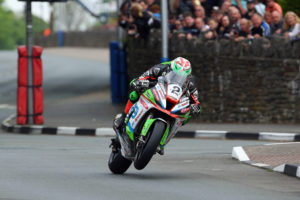The Isle of Man TT: Risk and reward on the ragged edge
Only marginally more competitors have won an Isle of Man TT race than those who have died trying. That is the risk attached to victory in a two-hour adrenaline rush that keeps riders and fans coming back year after year.
Conceived in 1907, the TT is unparalleled. The historic races comprise of six 38-mile laps of the island where bikes can reach 200mph on tight, twisting country roads.
“It is the pinnacle of speed, danger and risk. If you take any part of that away then it wouldn’t be what it is – the ultimate thrill,” said 2013 winner James Hillier. “If we hadn’t seen someone do it and done it ourselves then we wouldn’t believe it was doable to ride at that pace for that long,” he added.

Seeing the ride-along footage from a racer like Hillier does not make it any easier to believe – reminiscent only of someone playing the final level of a video game on expert difficulty for two hours straight, without the luxury of a restart button.
Davey Todd, the 25-year-old racer from Middlesbrough who finished sixth in the 2019 Senior race, said: “In other races you’re racing the competitors, but you race the circuit in the Isle of Man TT.”
Indeed, while the riders share mutual love and respect, the course itself is spiteful. It is out to get you from the start, which in itself embodies the skill and consequence associated with the race.
The Ragged Edge
Bike racing is a dangerous sport. Joey Dunlop, the granddaddy of the TT with an incredible 26 victories, survived all his triumphs only to be tragically killed at the age of 48 while racing in Estonia.
The TT itself has claimed 260 lives since 1907, and not just in the early years. As time goes on, bikes get faster and 63 riders have died racing the TT since the turn of the millennium. This represents an obvious concern, but the upsides are simply too good to keep riders and spectators away.
Todd said: “You can be photographed passing a 30mph sign going through a small village and you might be doing 200mph.
“It is trying not to blink for two hours. You make a mistake and there are no run-off areas or crash barriers, it’s a wall or a hedge or off the edge of a cliff or into a house – it’s not very forgiving if you do have a lapse in concentration.”
His fellow competitor Hillier added: “The hardest part is overcoming the instinct to slow down and not scare yourself. I refer to it as the self-preservation instinct.
“There are a lot of sections where your internal alarms are going off telling you to slow down, but then there’s that competitive drive telling you the opposite.”

Riders have no choice but to suppress their instincts to slow down, but the real-life consequences of being subject to such danger are, occasionally, unavoidable.
Daley Mathison, a close friend of Todd’s, tragically died during the superbike TT race in 2019.
Todd said: “We were so close. We were team-mates, we lived locally to each other, he was my best friend. All riders set off one at a time but for that race he set off just 10 seconds behind me and you do start to think when the race gets red flagged, ‘what if it’s him?’.”
After the tragic accident, Todd opted to race on. According to him, the mental task of completing a TT is the perfect vehicle for distraction.
In moments like that, the risks of taking part seem incomprehensible. Then again, most have never experienced the rewards.
Making it Make Sense
Pride and accomplishment go hand in hand with simply completing six laps of the TT. Two hours of faced fears, adrenaline and fierce competition at the top end of an enthralling sport.
Hillier said: “Once you’ve done it, normal life becomes quite mundane. That thrill factor is very hard to replicate anywhere else, it’s almost like drinking a fine wine and then going back to the cheap stuff.”
With this in mind, Hillier has been something of a connoisseur since his debut in 2008, thrusting himself into a group of less than 300 people who have won a TT race after taking the lightweight class in 2013.
“It was a special day for me, a big box ticked and something growing up I never thought possible,” said Hillier.
“I first went when I was 12 and if someone told me then that I would be there racing and eventually win one I would never have believed it.”
Given the immensely loyal following at the heart of the event, the COVID-19 pandemic has prompted cancellations in both 2020 and ahead of time in 2021.
The three-year hiatus by the time 2022 rolls around will be the longest since the end of the Second World War.
Hillier will be keen to add to his title, while Todd, an accomplished young rider who has only competed in the TT twice, will no doubt be itching to get back amongst the action.